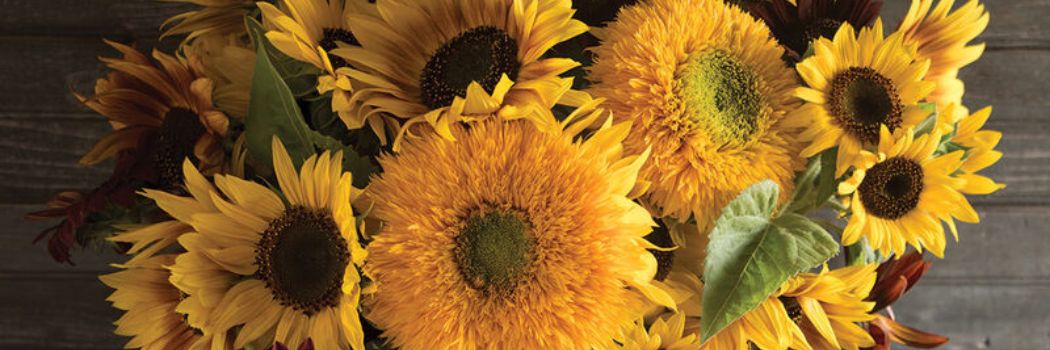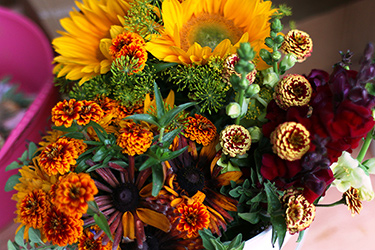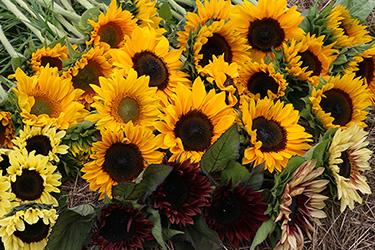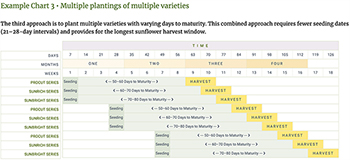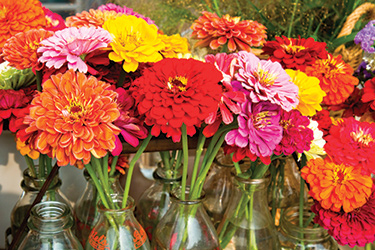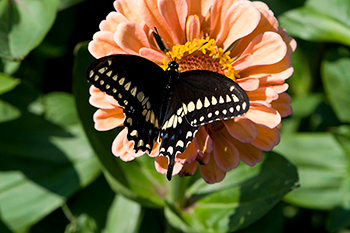- 3 Easy, Reliable, Productive Cut Flowers: Sunflowers, Zinnias & Rudbeckia
- 5 Factors That Determine Vase Life of Cut Flowers
- 2019 American Flowers Week: Combining the Art of Floral Design & Couture
- Celebrate the 7th American Flowers Week | Johnny's 2021 Botanical Couture
- Celebrating the 8th American Flowers Week | Johnny's 2022 Botanical Couture
- Collective Selling Models for Flower Farmers: Flower Hubs That Work
- 5 Cool Flowers to Plant Now | Lisa Mason Ziegler's Secrets for Growing Hardy, Cool-Season Annuals
- Cut-Flower Harvesting & Post-Harvest Care | Best Practices from Pros in the Slow Flower Community
- Cut-Flower Kit | Guide for Market Growers (PDF)
- Easy Cut-Flower Garden Map | For Growers New to Flowers (PDF)
- Easy Cut-Flower Garden Planner | For Growers New to Flowers (PDF)
- From Color to Climate: 5 Floricultural Trends Subtle & Seismic
- Flower Culture by Crop | Comparison Chart | Days to Germination, Weeks to Transplant, Days to Harvest (PDF)
- Flower Farmers' Favorite Fillers & Foliage | Recommendations from 3 Farmer-Florists
- Getting Started in Cut-Flowers | Top 15 Cuts
- Heat & Drought: How Flower Farmers Are Adapting to Changing & Challenging Climatic Conditions
- Introduction to Overwintering Flowers | Guide to Overwintering Flowers
- An Introduction to Producer Marketing Cooperatives | M Lund & Associates
- How Day Length Affects Cut-Flower Production
- Growing Flowers in Hoophouses & High Tunnels: Cool-Weather & Hot-Weather Options
- Growing Flower Seedlings for Profit
- Roadside Flower Stand Basics: Success Tips for On-Farm Retail
- Starting a U-Pick Flower Farm, From A-to-Z
- Year-Round Flower Production Strategy
- Overwinter Flower Trials | Multiyear Results for 30+ Crops | Johnny's Selected Seeds | XLSX
- Seeding Date Calculator | Johnny's Recommended Flowers for Overwintering | XLSX
- Just Add Flowers | An Introduction to Companion Planting for Vegetable & Herb Gardeners
- Pricing & Profitability for Flower-Farmers | Pointers from a Diversity of Pros
- Sustainable Farming Methods | A Survey of Flower Farmers' Best Practices
- Slow Flowers Palette & Petal Crushes | Evolving Colors & Shape-Shifts in Floral Industry Trends
- Johnny's and Slow Flowers | Johnny's Selected Seeds
- Slow Flowers | Celebrating Fifth-Season Regional Design Elements
- Slow Flowers Floral Forecast | A Summary of Industry Insights & Trends
- Building a Better Market Bouquet: Tips, Techniques & Recipes for Flower Farmers
- Slow Flowers | Tips for Staging On-Farm Floral Workshops | Johnny's Selected Seeds
- Wedding Wisdom 101 | 10 Beginner Tips for Entering the Wedding Floral Landscape
- Succession-Planting Flowers | Scheduling & Planning, Sowing Frequency, Recordkeeping & Recommendations
- Succession-Planting Interval Chart for Flowers
- Sustainable Floral Design | Techniques & Mechanics for Foam-Free Floristry | Tobey Nelson & Debra Prinzing
- Video: Mason Jar Bouquet Tutorial
- Video: How to Build a Bouquet
- Video: Tobey Nelson | Sustainable Floral Design | Slow Flowers Summit
- Video: Economic Considerations in Overwintering Cut Flowers | Johnny's Selected Seeds
- Top 10 Cut-Flower Varieties for Direct Seeding
- Video: Floating Row Cover | Baby "Cool Flower" Protection from Whipping Winter Winds
- Video: The Procona System for All-in-one Flower Harvest, Transport & Display
- Johnny's Overwinter Flowers Tunnel: Trellising, Supports, Ground Cover & Spacing
- Video: Irrigation Considerations for the Overwinter Flowers Tunnel | Johnny's Selected Seeds
- Video: Johnny's Overwinter Flowers Trial Recap
- Video: Producer Cooperatives for Small-Scale Farmers | Johnny's Webinar Series
- Climate Adaptation for Vegetable & Flower Farmers | Johnny's Educational Webinar Resources
- Chrysal Classic Professional 2 Transport & Display (Holding) Solution | SDS
- Choosing Flower Crops to Overwinter | Guide to Overwintering Flowers
- Chrysal Clear Universal Flower Conditioner | SDS
- U-Pick Power for Your Flower Farm | Johnny's Webinar Series
- Chrysal Professional 3 Vase Solution Powder | SDS
- Bloom to Boom: Flower Farm Profitability
- Webinar Slide Deck | U-Pick Power for Your Flower Farm | PDF
- Chrysal Professional 1 Hydration Solution | SDS
- Edible Flowers List: Top 20 Favorites from the Slow Flowers Community
- U-Pick Power for Your Flower Farm | Johnny's Webinar Series
- Floral Standards for Flower Farm Collectives and Cooperatives
- Chrysal Professional 2 Transport & Display T-Bag | SDS
- Eat Your Flowers: Serve Up That Wow Factor With Edible Flowers
- Chrysal CVBN Flower Conditioner | SDS
- When to Start Seeds for Overwintered Flowers | Guide to Overwintering Flowers
- Introduction to Forcing Flower Bulbs in Soil | Guide to Forcing Flower Bulbs
- Webinar Slide Deck | Flower Growing in Southern States | PDF
- Forcing Tulip Bulbs | Guide to Forcing Flower Bulbs
- 10 Tips for Building a Profitable Cut-Flower Business
- Chrysal Clear Bulb T-Bag | Cut-Flower Conditioner | SDS
- Video: Flower Growing in Southern States | Johnny's Webinar Series
- Flower Growing in Southern States | Johnny's Educational Webinar Series
- Chrysal Clear Bulb Flower Conditioner | SDS
- Choosing Tulip Varieties for Forcing | Guide to Forcing Flower Bulbs
- Snapdragon Groups Explained
- Flowering in the South: Profiles of 5 flower farmers who cope with temperature, humidity, pest & weed pressure
- Webinar Slide Deck | New-for-2023 Flowers & Floral Supplies | PDF
3 Easy, Reliable & Productive Cut Flowers

Hillary Alger, Flowers Product Manager, R&D, Johnny's Selected Seeds
On This Page
by Hillary Alger, R&D Flowers Product Manager
The Short-List
For home gardeners and direct-to-market growers alike, there are some common features nearly everyone looks for in their cut flowers. Most look for flowers that are:
- Beautiful
- Productive
- Fast growing
- Relatively low maintenance
- Easy to harvest
These features are universally desirable in cut flowers because they increase the chances of success—whether you are just delving in or you are a seasoned grower whose plans demand plentiful no-fuss performers. Of all the cut-flower options we have trialed and added to our offerings, our recommended short-list are the ones you can depend on year after year—whatever your experience level.
We call these "tier-one flowers" because they:
- Look outstanding both in the field and in the vase
- Bloom prolifically
- Make comparatively few demands, and
- Won't keep you waiting all summer long before blooming.
1 • Best Sunflowers For Cutting
Sunflowers top our short-list because they germinate in under two weeks, require only a few months before they're ready to harvest, and consistently produce cheery blooms enjoyed by all.
Sunflowers come in a variety of forms, including dwarf and perennial varieties, but for our purposes we'll focus on the two types known to excel as cut flowers—single-stemmed sunflowers and branching sunflowers.
Single-Stem Sunflowers
Scoring first-place for quality and reliability, single-stem sunflowers are a one-cut deal—producing one sturdy, high-quality stem per seed or plant. In addition to their easygoing ways and high-quality blossoms, single-stemmed varieties offer quick, dependable production time (relatively few days to maturity). They are also easy and quick to harvest—cut the single stem at your desired length and strip a few leaves—no need to bend over or reach up to hunt for stems.
Single-stem varieties are available in a number of shapes and colors. The classic, golden yellow with dark centers are popular for bright or earthy high-summer and autumn bouquets, whereas those with green centers or lemon-colored petals are useful for fresh-looking spring and early-summer bouquets. The ProCut Series sunflowers are a favorite for their unmatched, fast production time, wide range of colors, and full, graceful booms.
Branching Sunflowers
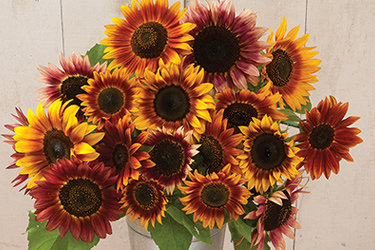
While single-stemmed varieties have branching sunflowers beat for production speed, branching sunflowers offer two distinct advantages of their own.
- They produce multiple blooms per plant.
- They extend the harvest window from a single planting by two to three weeks.
These are very useful features if you are not sure exactly when you will want to harvest, or, if you want to harvest gradually over a more protracted period of time.
Branching varieties are also valued for their greater diversity of colors, shapes, and flower size.
Structurally, however, the stems of branching sunflowers are thinner, relative to their single-stem counterparts. We do our best to select for length and strength in the stems of our branching sunflower varieties in our trials, but it is important to keep this in mind when handling this group.
Succession-Planting Sunflowers
Another major advantage to sunflowers is that they lend themselves beautifully to succession-planting, so you can achieve a season-long harvest. There are two primary ways to plant in order to achieve a successive harvest:
- planting multiple varieties with various maturity times and/or
- planting multiple times throughout the season
Because sunflowers—especially single-stem varieties—have a fast production time, both methods can be used separately or in combination for a full season of bright blooms.
Additional Key Attributes
- Bloom Time: Early summer to early fall
- Harvest Cues: When petals begin to lift off the face or disc of the flower, or when petals are perpendicular to the face or disc
- Floral Form: Focal flower
- Vase Life: 7–10 days
More About Sunflowers
2 • Zinnias—Workhorse of (Many) a Different Color
When you need dependable, low-maintenance cut flowers, think zinnias. They don't require special attention or conditions, just full sun and good soil. Even better, zinnias come in just about every color (except blue). There is a zinnia for just about every occasion, making them a useful cut for arrangements ranging from country to classic.
Color
The color range of zinnia blooms is truly impressive—from the intense, high-chroma Benary's Giant Series to the delicate, subdued tones of 'Creamy Yellow', 'Oklahoma Salmon', and 'Queen Red Lime'. Our trials have yielded up a wide palette of high-performing choices that will work well for you, whether you're into floriculture for business or pleasure.
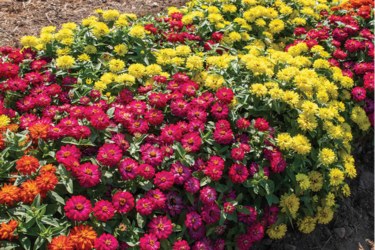
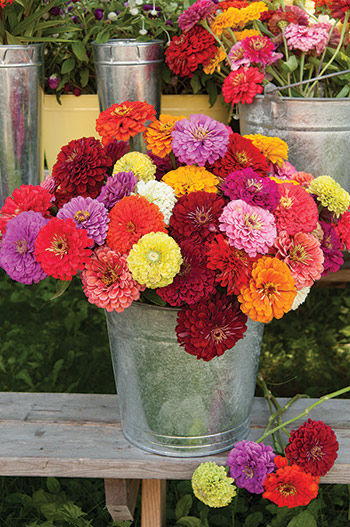
Size & Shape
Another plus for zinnias is the breadth of size and shape they offer. The large, 4–6" diameter giant dahlia-bloom and cactus-bloom types are the most well known for their grandeur and ability to easily fill out bouquets and bunches. At the other end of the scale, dwarf zinnias are exceptionally productive, and light up bouquets with flashes of color. With 1–2½" blooms, the smaller-flowered or pompom types, such as 'Sunbow' and the Oklahoma Series, are generally more durable, with sturdy stems and compact heads—and both are available in mixes that flower in a spectrum of colors.
Disease Prevention
Zinnias are susceptible to some common plant diseases, such as powdery mildew and alternaria leaf blight. Keep flowers harvested and snip away spent blooms and foliage to diminish conditions favorable to these fungal pathogens, and to keep plants healthy and productive.
Succession Planting Zinnias
Zinnias typically continue producing blooms as long as the season lasts, and as long as the blooms are cut or trimmed away. That said, the plants can get tired after a time, reducing quality and quantity of bloom production. For a bounty of top-quality blooms all season long, we recommend two to three succession plantings, following your initial planting, each planted a couple weeks apart. The number of sequential plantings you can make depends on your growing zone and your particular requirements and preferences.
Additional Key Attributes
- Bloom Time: Early summer to early fall
- Harvest Cues: When the pollen begins to form and flowers have completely filled out
- Floral Form: Larger blooms serve as arrangement focal points; smaller blooms as accents
- Vase Life: 7–10 days
More About Zinnias
3 • Rudbeckia: The Sleeper Flower
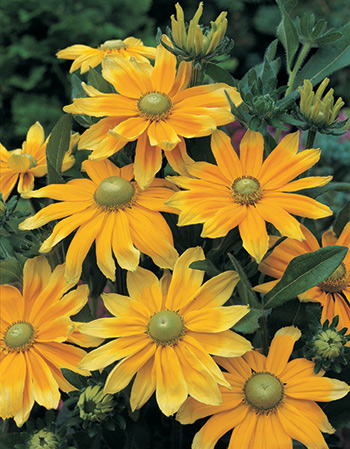
Rudbeckia are every bit as productive as zinnias and a distant relation to both zinnias and sunflowers, all of which are in the Asteraceae family (see Big Happy Family). Rather than the upwardly, forward-facing petals of the sunflower, rudbeckia petals angle downward and away from the center, presenting their buttonlike disk at the flowers' apex. This is one of the key features of rudbeckia that make them so easy to utilize in bouquet work—and that put them on our short list.
While they do have a higher number of days to maturity than sunflowers and zinnias, most of that period is devoted to seedling development. They will start blooming in July, from transplant, here in Maine, which is earlier than many other cut flowers.
Color
Many of us know rudbeckia by the common name of their most common group, the Black-Eyed Susans, but the disc color of rudbeckias can also be green, brown, and in-between shades. The petals are sunny, warm, and dramatic in tone, ranging from chocolate to cherry red, copper, and gold. Brighter varieties offer a fresh appeal, with lighter yellow petals and green centers, as in the case of All-America Selections Winner 'Prairie Sun'.
Rudbeckia hirta
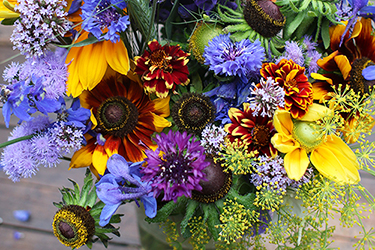
Although categorically a tender perennial, this species is most often grown as an annual for cut-flower production, as first-year plantings are more dependable in most regions. Plants are naturally well branched, without the need to pinch out the apical bud. Rudbeckia hirta is quite susceptible to powdery mildew. Keep flowers harvested and snip away spent blooms and foliage to keep plants healthy and productive.
Arrangement Tip: Blooms (Rudbeckia hirta) with damaged petals can still serve as useful textural accents in bouquets by removing the row of petals to reveal the lovely green calyx surrounding the button-like center.
The term composite refers to the nature of their flower head, or inflorescence, which comprises a central, often disk-like section of tiny, tightly packed ray florets encircled by the marginal petal-like ray flowers.
This is one of the largest, most cosmopolitan families of flowering plants in the world.
With an estimated 23,000+ different species in this family, you will see many variations in the configuration of the infloresence.
And, while not all are a breeze to cultivate, on the whole they are a well-adapted family in comparison to many other flowers—relatively carefree and forgiving in their demands.
Rudbeckia triloba
This species is a tall, productive, branching perennial that produces sprays of multiple, button-sized blooms on strong, thin stems that are easy to harvest. Blooming in late summer and early fall, Rudbeckia triloba makes autumn bouquets sparkle. Powdery mildew doesn't seem to be nearly as much of an issue with Rudbeckia triloba, which grows free of powdery mildew in our variety trials.
Additional Key Attributes
- Bloom Time: Early summer to early fall
- Harvest Cue: Just before flowers are completely open
- Flower Form: Larger blooms serve as arrangement focal points; smaller blooms (R. triloba) as accents or filler
- Vase Life: 8–10 days
More About Rudbeckia
Learn More
This is just a glimpse at three tier-one heroines of the cut-flower garden. We chose this trio for their reliability, productivity, beauty, and relative low maintenance. There are many additional varieties you can consider for your particular needs. Make a checklist of features you look for in your flowers, or use ours as a short-cut.
Here are a few more resources to help you choose and plan an easy cut-flower strategy this year.
- If you're just starting out and feeling ambitious, consider our Easy Cut-Flower Garden Set. The elements can be purchased individually or as a complete set, and together yield a handsome mix of cuts all season long. Accompanied by a detailed Garden Planner and Garden Map, it provides a solid template for getting started.
- For anyone getting ready to branch out and grow their business by adding flowers to the mix, we offer a Cut-Flower Kit for Market Growers.
- Here is our full selection of Easy-Choice Cut Flowers.
- And for some quick inspiration, watch our Mason Jar Bouquet Video.


